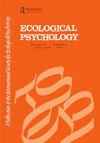Collective Dissipative Structures, Force Flow Reciprocity, and the Foundations of Perception–Action Mutuality
IF 1.7
3区 心理学
Q3 PSYCHOLOGY, EXPERIMENTAL
引用次数: 8
Abstract
Abstract Physical systems maintained far from equilibrium exhibit self-organization of structure and behavior. These dissipative structures can exhibit life-like qualities and activities, such as collective and coordinated behaviors. We review such collective behaviors in electrical and chemical dissipative structures. Electrical dissipative structures can functionally coordinate their behaviors to maximize the rate of entropy production. Coupled oscillating electrical dissipative structures exhibit in-phase and anti-phase coordinative modes characteristic of biological coupled oscillators. Chemical swimmers form collective flocks with emergent properties, including sensitivities to magnetic and thermal fields, and rudimentary navigational capabilities. We review previously published work on electrical and chemical dissipative structures in the context of functional coordination. We also present a novel study of the functional coordination within the electrical dissipative structure. These collective behaviors are enabled by coupling of dissipative entities through diffuse energetic fields. We propose that the causal structure of the physics underlying these collective phenomena may be the same as that supporting coordination between organisms. We draw analogies between thermodynamic forces and flows driving the non-living dissipative structures and the perception–action mutuality which supports biological behavior.集体耗散结构、力流互易性和感知的基础——行动互易性
远离平衡的物理系统表现出结构和行为的自组织性。这些耗散结构可以表现出类似生命的品质和活动,例如集体和协调的行为。我们回顾了电学和化学耗散结构中的这种集体行为。电耗散结构可以在功能上协调它们的行为,以最大化熵产生率。耦合振荡电耗散结构表现出生物耦合振荡器的同相和反相协调模式特征。化学游泳运动员组成集体,具有突发特性,包括对磁场和热场的敏感性,以及基本的导航能力。我们在功能配位的背景下回顾了先前发表的关于电和化学耗散结构的工作。我们还提出了一个新的研究功能协调在电耗散结构。这些集体行为是通过耗散实体通过扩散能量场的耦合实现的。我们提出,这些集体现象背后的物理因果结构可能与支持生物体之间协调的结构相同。我们在驱动非生物耗散结构的热力学力和流动以及支持生物行为的感知-行动相互性之间进行了类比。
本文章由计算机程序翻译,如有差异,请以英文原文为准。
求助全文
约1分钟内获得全文
求助全文
来源期刊

Ecological Psychology
PSYCHOLOGY, EXPERIMENTAL-
CiteScore
3.30
自引率
10.50%
发文量
8
期刊介绍:
This unique journal publishes original articles that contribute to the understanding of psychological and behavioral processes as they occur within the ecological constraints of animal-environment systems. It focuses on problems of perception, action, cognition, communication, learning, development, and evolution in all species, to the extent that those problems derive from a consideration of whole animal-environment systems, rather than animals or their environments in isolation from each other. Significant contributions may come from such diverse fields as human experimental psychology, developmental/social psychology, animal behavior, human factors, fine arts, communication, computer science, philosophy, physical education and therapy, speech and hearing, and vision research.
 求助内容:
求助内容: 应助结果提醒方式:
应助结果提醒方式:


